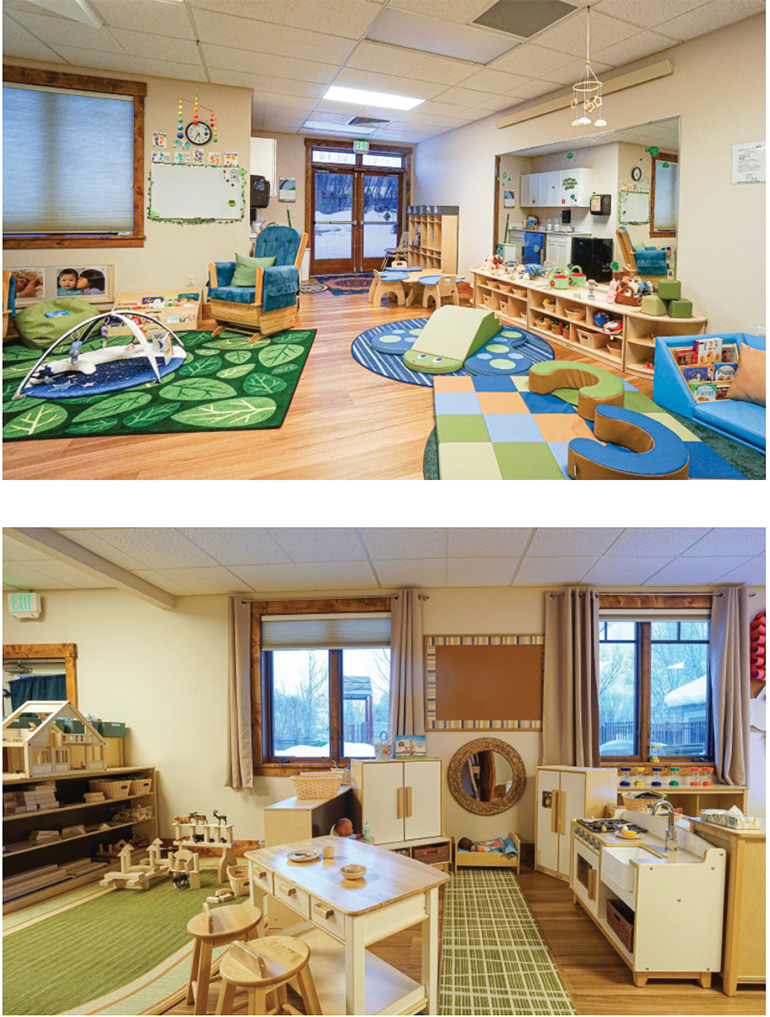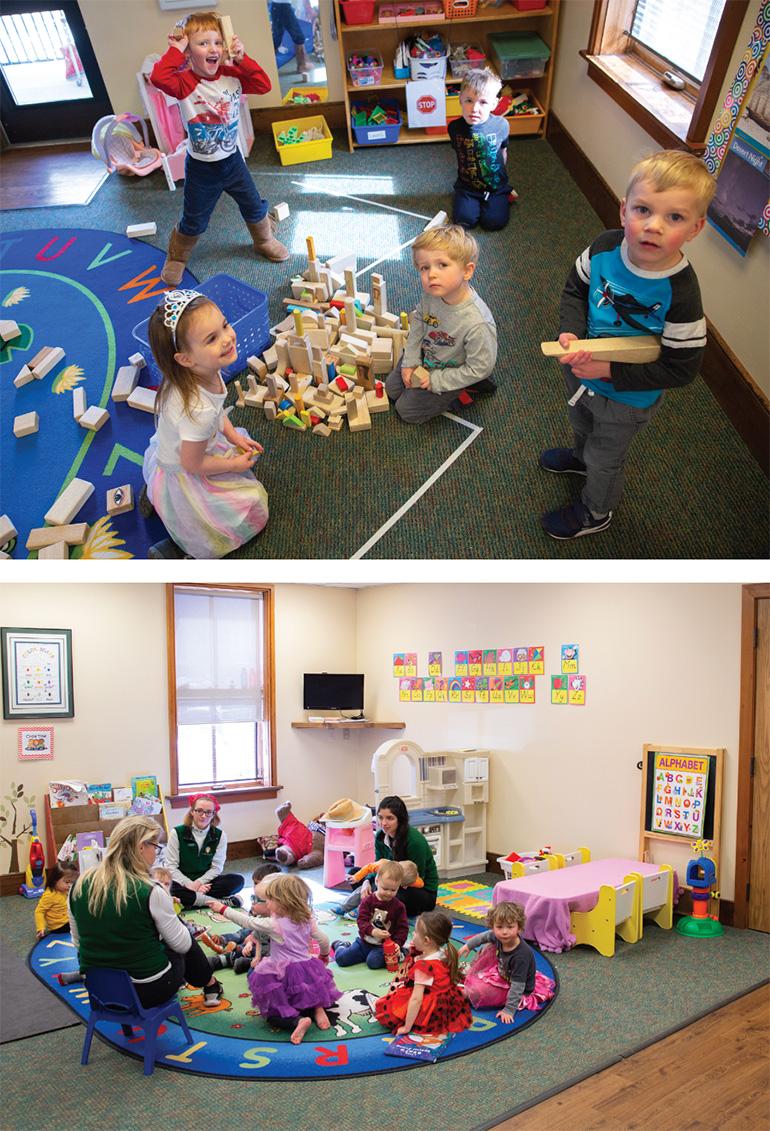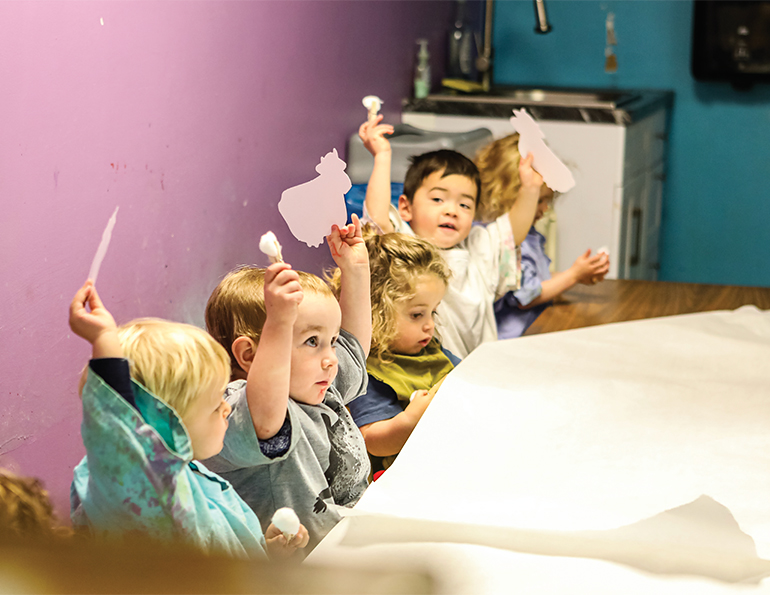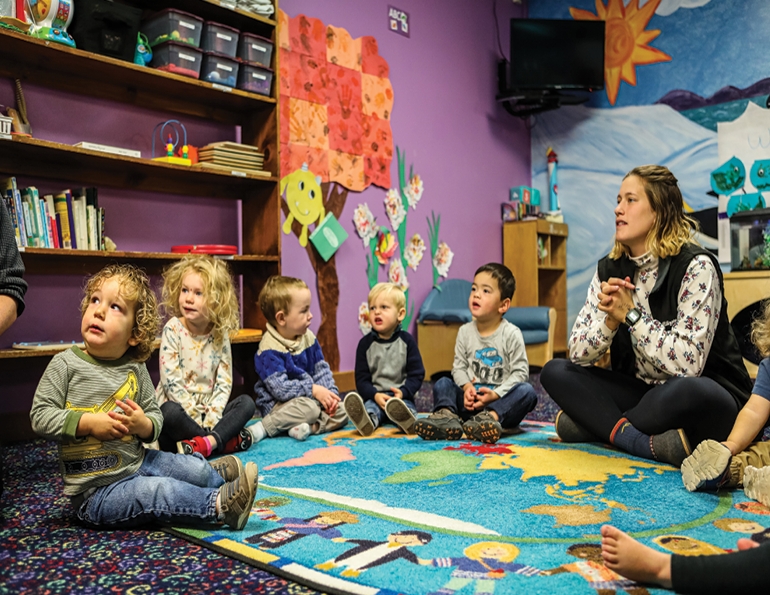Access to quality and affordable child care is very limited in many mountain towns, and can be the difference between a talented employee being able to work or not. More and more resorts are recognizing this and taking action by offering discounted or even free child care in an effort to attract and retain quality staff.
Last year, Smugglers’ Notch Resort made headlines in northern Vermont when it announced that it would offer free on-site child care for its employees. Prior to offering the benefit, only 11 employees used the Treasures Child Care Center to take care of their little ones. Now, 55 employees from several departments, including housekeeping, ski school, food and beverage, and guest services, have kids in the program.
“Employees no longer having to worry about child care has resulted in happier and more productive employees,” says Harley Johnson, director of Smugglers’ children’s programs and snow sports university, who adds that both part-time and full-time staff can use the benefit on the days they work. On non-working days, staff pay just $35 to use the child care.
Steamboat Resort, Colo., also went to considerable lengths to provide child care for staff children. During Covid times, with many centers shut down, Steamboat employees with young kids struggled to find child care, including director of communications Loryn Duke, who became a mom in March 2021. “I had to get a nanny,” she says. “There was only one community center with space for infants and there was a waitlist.”
 Steamboat’s new employee child-care facility went from concept to completion in just 15 months after staff proposed a plan to resort management.
Steamboat’s new employee child-care facility went from concept to completion in just 15 months after staff proposed a plan to resort management.
Duke, along with other parents impacted by the Steamboat area’s child care desert, presented a plan to resort management to build a new employee-based child care facility, driving home the idea that supporting a child care center would help support Steamboat staff members.
A CRITICAL INVESTMENT
Once the green light was given, “it went from concept to doors open in 15 months,” says Duke. “It was absolutely a case of the stars aligning,” she adds, explaining that the project coincided with Steamboat being awarded a $500,000 grant from the Colorado Department of Human Services through a new program aimed at expanding child care in the state. The company then matched the grant with another $500,000 to make it happen.
High demand. Once open, “we had 49 children register within 24 hours,” she says. The new facility is conveniently located for employees, who receive a 20 percent discount on child care. Employees also get priority at the center, which can take 35 children. Leftover spots are then opened to community members.
Last year, Breckenridge Ski Resort, Colo., recognized employee child care as a critical community need in Breckenridge and across Summit County for working families. So, the resort converted one of its existing guest child-care centers to an employee-focused operation, which not only provides a benefit to resort employees—who pay $75 a day versus the standard guest rate of $215-$235—but also to the broader community by taking employees off local child care waitlists.
“It’s a major investment and something we see as a great benefit to our employees,” says Brittany Comfort, senior manager of child care at the resort.
As important a benefit as it is, implementing employee child care is not easy in terms of costs and logistics. For example, it costs Steamboat $200,000 a year to subsidize a 20 percent discount for child care.
FINANCING AND LOGISTICS
To manage the logistics and costs, Steamboat leveraged a variety of resources. After a talent search, the team brought on Sarah Nicolson as director, who led everything from facility construction to the hiring of staff. In addition, the resort was able to take advantage of a newly launched Colorado program called Executives Partnering to Invest in Children (EPIC).
EPIC had recently partnered with the Colorado Department of Early Education to provide tools to support child care facilities through grants, community partnerships, or direct support. Among the tools were “Design Lab” sessions to teach businesses the ins and outs of setting up a center, from staffing requirements to finances to square footage needed for a facility.
“We didn’t know how to do child care,” says Duke, who also nnotes that Steamboat’s project was amongst the 8-10 businesses chosen for the EPIC program, and the only ski resort.
Grants are another resource to help ski resorts implement or enhance their child care services.
In the East, Killington was able to get $65,000 in Vermont state grants to support its child care center, which takes employee children 8-weeks- to 4-years-old for full-time, year-round care. “These grants work to help us retain staff as well as improve the infrastructure in child care facilities,” says Kristel Killary, Killington brand marketing and communications manager. “The funds were used to install mini splits to improve both heating and cooling as we are now a year-round facility.”
In California, there are some state funds available to help child-care workers seek out continuing early education credits. “We get a $10,000 stipend per year to split up amongst the [child care] staff if they go through continuing education,” says Craig Albright, VP of skier services at Mammoth Mountain Resort, which has two child care facilities, one for employees and one for guests, that can accommodate 60 children.
Grant limitations. Albright was unaware, however, of any grants available to help with other aspects of child care operations. For example, Mammoth had explored building a new child care facility years ago, but pursuing state grants was a dead end. “The way the ski business operates on net profits makes it difficult,” he says. “For instance, federal child care tax credits are difficult for ski areas to qualify for.”
Deer Valley, Utah—which has a child care center for ages 2-months- to 12-years-old, open to employees at a discounted rate outside of certain blackout dates—encountered similar road blocks when it pursued grants. “Because we are for profit, many grants are not available for us to apply for,” says Cidney Judkins, manager of children’s programs. “However, we do accept any subsidies that the employee has applied for and/or received from the state or other entities” to help pay for child care services.
 Deer Valley’s child care center provides discounted employee coverage for kids ages 2-months- to 12-years-old.
Deer Valley’s child care center provides discounted employee coverage for kids ages 2-months- to 12-years-old.
LICENSES AND STATE REQUIREMENTS
In addition to costs associated with infrastructure and maintenance, there are state regulations and licensing requirements that resorts need to comply with, such as a limit on the number of kids per square foot, caregiver-to-child ratio, and quality of care and educational requirements. Some regulations have become stricter, especially for infant care, in recent years, too.
“It’s not like the old days,” says Albright. “The combination of fewer in-home centers and the regulations surrounding child care means there are more hoops to jump through,” he explains.
Education requirements. Recent studies that point to the importance of infant and toddler development and changes in state and federal regulations have increased the demand for child-care workers who have early education credits or degrees. That makes it harder for ski resorts to find qualified staff. And, although pay has increased for child-care providers, it still lands in the $20/hour range, which may not be a livable wage in ski communities where housing costs are through the roof.
In fact, when Mammoth Hospital in Mammoth Lakes, Calif., just below the resort, recently pursued renting space at a vacant church to set up a child care facility solely for its employees, locals said it was practically a bidding war to win over one of the few qualified teachers in town. “Staffing is the single biggest obstacle to overcome,” says Albright.
When it comes to educational requirements for child care staff, many of the resorts help to pay for this effort. For example, Mammoth receives grant money to help reimburse its caregivers and Killington pays for its staff’s required education.
“In addition to paying for educational requirements for staff, we have also focused on providing a better living wage in order to make onboarding easier for our new-hire child care providers,” says Killary.
Quality assurance. While state licensing requirements may be strict, the rules ensure a facility is meeting a high standard, which is good. “We view licensing as a positive,” says Killary, who notes that Killington has an exceptional program that her own young daughter attends. “Our child care does a terrific job of adhering to the state regulations, which ensures the safety and quality of child care. It sets a standard and expectation for a level of service and experience for each and every child.”
“These are all best practices,” says Deer Valley’s Judkins of Utah’s safety protocols and procedures, “and we go above and beyond many measures such as smaller teacher-to-child ratios.”
A WIN-WIN
A lack of affordable and available child care is a nationwide problem. According to the Bipartisan Policy Center, millions of Americans work less than they used to or not at all because they can’t find someone to take care of their children. So, it is natural that many ski area owners and operators have responded with improved employee child care benefits, even if it means operating their centers at a loss.
As resort operators consider ways to alleviate the employee child-care burden, from offering child care at discounted rates to improving the quality of the operation to opening employee-only centers, know that many consider it a win-win for employees and their employers.
Consider this feedback Steamboat received from the MTS Summit Award selection committee, which recently recognized the resort with a Mountain Travel Symposium Summit Award for the creation of its child care center:
“The MTS Summit Award selection committee was incredibly impressed by Steamboat’s child care center for several reasons. First, the fact that Steamboat recognized it had a responsibility to solve this problem for its employees and community is unique and not yet standard practice by most corporations. And then, for Steamboat to accomplish the task in such a short amount of time was equally as incredible, not to mention operating the center comes at a loss. This will greatly impact Steamboat’s ability to keep its female [and male] employees in the workforce and create a framework for others to follow.”
“Our goal is to always prioritize our staff,” says Steamboat’s Duke. That makes employee child care benefits a worthy investment.
 Raise your hand for child care! (Killington, Vt.)
Raise your hand for child care! (Killington, Vt.)






